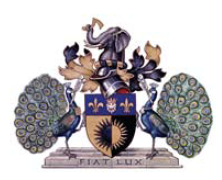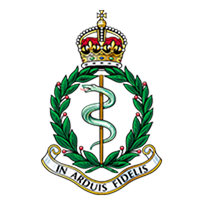
Robert Seymour Bridges was a British poet who was Poet Laureate from 1913 to 1930. A doctor by training, he achieved literary fame only late in life. His poems reflect a deep Christian faith, and he is the author of many well-known hymns. It was through Bridges's efforts that the poet Gerard Manley Hopkins achieved posthumous fame.

Moorfields Eye Hospital is a specialist National Health Service (NHS) eye hospital in Finsbury in the London Borough of Islington in London, England run by Moorfields Eye Hospital NHS Foundation Trust. Together with the UCL Institute of Ophthalmology, which is adjacent to the hospital, it is the oldest and largest centre for ophthalmic treatment, teaching and research in Europe.

The Royal Army Medical Corps (RAMC) is a specialist corps in the British Army which provides medical services to all Army personnel and their families, in war and in peace. The RAMC, the Royal Army Veterinary Corps, the Royal Army Dental Corps and Queen Alexandra's Royal Army Nursing Corps form the Army Medical Services.

The Royal Victoria Hospital (RVH), colloquially known as the "Royal Vic" or "The Vic", is a hospital in Montreal, Quebec, Canada. It forms the largest base hospital of the McGill University Health Centre (MUHC), which is affiliated with McGill University. The hospital was established in 1893 and was based at Pine Avenue, now known as the Legacy site, until 2015, when major hospital operations were moved to the Glen site, named for the former Glen railway yards. The future uses of the Legacy site are now under study and it seems likely that the site, which is adjacent to its main campus, will be taken over by McGill University.

Manchester Royal Infirmary (MRI) is a large NHS teaching hospital in Chorlton-on-Medlock, Manchester, England. Founded by Charles White in 1752 as part of the voluntary hospital movement of the 18th century, it is now a major regional and national medical centre. It is the largest hospital within Manchester University NHS Foundation Trust, and based on its Oxford Road Campus in South Manchester where it shares a site with the Royal Manchester Children's Hospital, Manchester Royal Eye Hospital and Saint Mary's Hospital as well as several other educational and research facilities. The Hospital is also a key site for medical educational within Manchester, serving as a main teaching hospital for School of Medical Sciences, University of Manchester.
The London School of Medicine for Women (LSMW) established in 1874 was the first medical school in Britain to train women as doctors. The patrons, vice-presidents, and members of the committee that supported and helped found the London School of Medicine for Women wanted to provide educated women with the necessary facilities for learning and practicing midwifery and other branches of medicine while also promoting their future employment in the fields of midwifery and other fields of treatment for women and children.

The Royal Infirmary of Edinburgh (RIE) was established in 1729, and is the oldest voluntary hospital in Scotland. The new buildings of 1879 were claimed to be the largest voluntary hospital in the United Kingdom, and later on, the Empire. The hospital moved to a new 900 bed site in 2003 in Little France. It is the site of clinical medicine teaching as well as a teaching hospital for the University of Edinburgh Medical School. In 1960 the first successful kidney transplant performed in the UK was at this hospital. In 1964 the world's first coronary care unit was established at the hospital. It is the only site for liver, pancreas, and pancreatic islet cell transplantation in Scotland, and one of the country's two sites for kidney transplantation. In 2012, the Emergency Department had 113,000 patient attendances, the highest number in Scotland. It is managed by NHS Lothian.

St Thomas's Hospital Medical School in London was one of the oldest and most prestigious medical schools in the UK. The school was absorbed to form part of GKT School of Medical Education.

Barbara Mary Ansell, CBE, FRCP, FRCS was a British medical doctor and the founder of the field of paediatric rheumatology. Ansell was notable for outstanding contributions to the advancement of paediatric knowledge, specifically defining chronic joint disorders and the improvement of their management.

Dame Sarah Ann Swift, GBE, RRC was an English nurse and founder in 1916 of the College of Nursing Ltd. which became the Royal College of Nursing. The College of Nursing created the first registers of nurses, a blueprint for the introduction of Nurse registration in the United Kingdom.

Dame Edith Mary Brown, was an English doctor and medical educator. She founded the Christian Medical College Ludhiana in 1894, the first medical training facility for women in Asia, and served as principal of the college for half a century. Brown was a pioneer in the instruction of Indian female doctors and midwives with modern western methods.

James Yearsley (1805–1869), aural surgeon, was born in 1805 to a north-country family settled in Cheltenham.

The Royal Waterloo Hospital for Children and Women was a hospital located on the corner of Waterloo Bridge Road and Stamford Street near Waterloo station in London, England. The current building was designed by noted ecclesiastical architect Sir Charles Nicholson at a cost of £45,000 and included an outpatients' department and inpatient accommodation of 90 beds. The hospital closed in 1981 and is now a dormitory building for the London branch of the University of Notre Dame.

Cecil Willett Cunnington was an English medical doctor and collector, writer and historian on costume and fashion. When he died The Times called him the Leading Authority on English Costume. He and his wife Phillis Emily Cunnington (1887–1974) worked together not only in their medical practice but also on their collection and writing. In 1947 the Cunningtons' extensive costume collection was acquired by the Manchester City Art Gallery and the Gallery of Costume at Platt Hall was opened.

David Maclagan MD, FRSE, FRCSEd, FRCPE was a prominent Scottish medical doctor and military surgeon, serving in the Napoleonic Wars. He served as President of both the Royal College of Physicians of Edinburgh and the Royal College of Surgeons of Edinburgh. He was Surgeon in Scotland to Queen Victoria.
Robert Scot Skirving (1859–1956) was a physician and surgeon in Australia. He was born in the United Kingdom. The University of Sydney named the Scot Skirving Prize in his honour.
Diana Jean Kinloch Beck was the first British female neurosurgeon. She established the neurosurgery service at the Middlesex Hospital in London. In 1952 she gained a public profile for performing life-saving surgery on A. A. Milne.
Armstrong Todd (1826–1873) was a nineteenth-century London surgeon credited with researching new medical conditions and procedures, including anesthetics.
Phillis Emily Cunnington was an English medical doctor and collector, writer and historian on costume and fashion. She and her husband Cecil Willett Cunnington (1878–1961) worked together not only in their medical practice but also on their collection and writing. In 1947, the Cunningtons' extensive costume collection was acquired by the Manchester City Art Gallery and the Gallery of Costume at Platt Hall was opened.
John Bishop, was an English surgeon and medical writer. He studied at St. George's Hospital; obtained the diploma of Royal College of Surgeons in 1824; was senior surgeon to the Islington dispensary, and surgeon to the Northern and St. Pancras dispensaries. He also wrote surgical works.


















